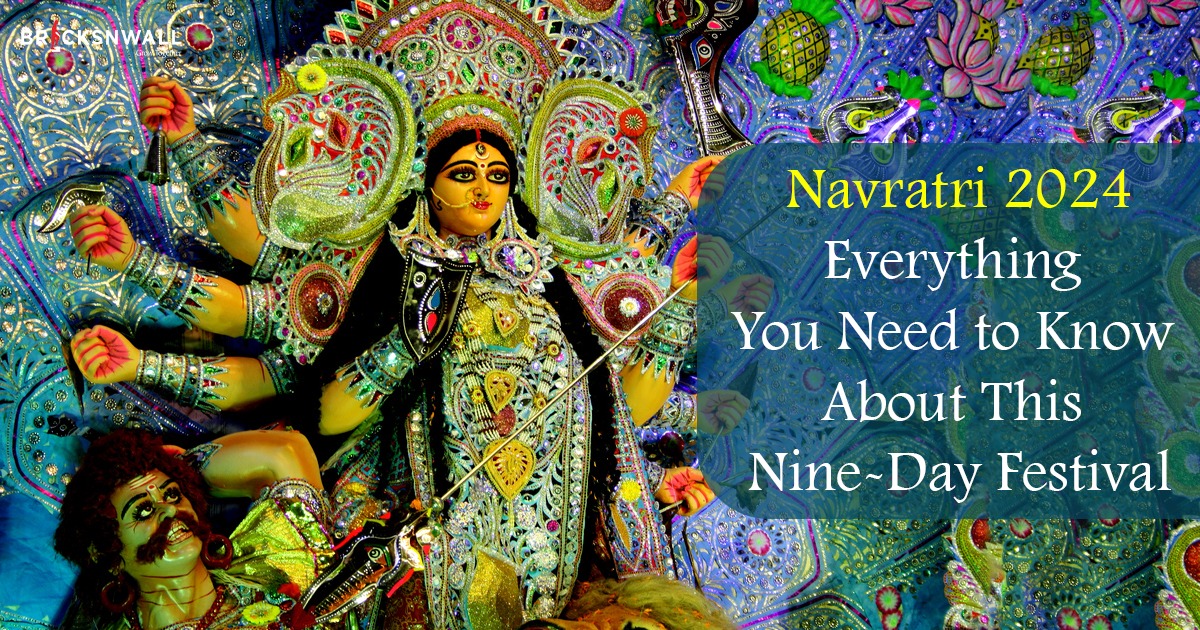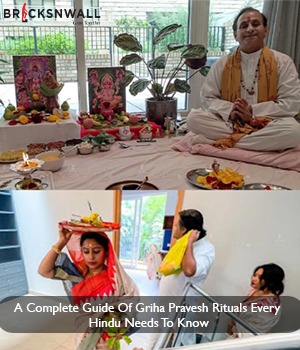Navratri 2024- Everything You Need to Know About This Nine Day Festival
Bricksnwall Trusted Experts

Navratri is more than simply a festival; it is a nine-day spiritual journey filled with devotion, colour, and happiness. Whether you're fasting, dancing the night away at Garba and Dandiya-raas, or praying to Goddess Durga's nine glorious forms, Navratri is a time for introspection, renewal, and joy. This guide will explain the meaning of Navratri, dates, regional celebrations, fasting recommendations, customs, dress trends, and much more.
What is Navaratri? Spiritual Significance and Origins
Navratri comes from the Sanskrit words Nav (nine) and Ratri (nights). During these nine days, devotees worship the nine forms of Goddess Durga, seeking divine blessings for prosperity, health, and success. Navratri 2024 will be commemorated from October 3 to October 12, coinciding with the start of fall, a season of regeneration and spiritual cleansing.
Navratri 2024 Dates and Festival Calendar
|
Day
1 (October 3): |
Pratipada
– Dedicated to Goddess Shailaputri |
|
Day
2 (October 4): |
Dwitiya
– Worship of Goddess Skandamata |
|
Day
3 (October 5): |
Tritiya
– Devoted to Goddess Chandraghanta |
|
Day
4 (October 6): |
Chaturthi
– Honoring Goddess Kushmanda |
|
Day
5 (October 7): |
Panchami
– Worship of Goddess Brahmacharini |
|
Day
6 (October 8): |
Shashthi
– Devoted to Goddess Katyayani |
|
Day
7 (October 9): |
Saptami
– Honoring Goddess Kalaratri |
|
Day
8 (October 10): |
Ashtami
– Celebrating Goddess Mahagauri |
|
Day
9 (October 11): |
Navami
– Worship of Goddess Siddhidatri |
|
Day
10 (October 12): |
Vijayadashami
or Dussehra |
How is Navratri celebrated? Rituals and Traditions throughout India
Navratri is celebrated throughout India, however
how it is observed varies by region:
- In Gujarat, the nights are filled with the vivid energy of Garba and Dandiya dances, in which men and women dress in traditional attire and dance in circles using clapping hands or sticks.
- In West Bengal, Durga Puja is the principal event, with large pandals, processions, and statues of Goddess Durga. The last day, Vijayadashami, sees the idols immersed in water, symbolising the goddess' return to her heavenly abode.
- In Tamil Nadu, people celebrate Bommai Golu, which involves arranging dolls in an artistic display that depicts incidents from Hindu mythology.
- In Karnataka and Maharashtra, Navratri is related with Dussehra, which features processions, dances, and festivals commemorating Lord Rama's victory over Ravana.
- While the cultural forms vary, the core idea remains consistent: devotion to Goddess Durga, prayer, and fasting.
The Nine Days of Navratri: Goddess Worship, Colours, and Daily Significance
Each day of Navratri is dedicated to a unique
goddess, and followers perform Navratri puja, offer bhog, and chant Navratri
mantras. Temples are decorated with lights and flowers, and spiritual rituals
such as Havan (fire offerings) are performed.
This is a quick guide:
Day one : Goddess Shailaputri (yellow)
Indicates strength and stability. Yellow represents positivity and kindness.
Day Two: Goddess Skandamata (Green)
It is associated with growth and tranquilly.
Day three: Goddess Chandraghanta (Grey).
Depicts boldness and courage.
Day four: Goddess Kushmanda (orange)
Orange is associated with the formation of the
universe and represents passion.
Day Five: Goddess Brahmacharini (White).
White symbolises purity and serenity.
Day six: Goddess Katyayani (Red)
Red represents daring and aggressiveness.
Day Seven: Goddess Kalaratri (Blue)
Blue symbolises strength and protection from
evil.
Day eight Goddess Mahagauri (Pink)
The colour that symbolises love, beauty, and
compassion.
Day nine, Goddess Siddhidatri (Purple)
Representing ambition and spiritual force.
During the nine days of Navratri, devotees wear in these colours to honour the deity associated with that day.
How to Plan for Navratri 2024: Fasting, Puja, and Decorations
Navratri preparations entail both spiritual and
physical aspects. Navratri fasting is a common ritual in which many people
abstain from grains, meats and alcohol in favour of fruits and other Navratri
meals. Devotees also perform daily pujas with flowers, diyas, and incense
sticks.
Navratri house décor options include colourful
rangolis, floral garlands, and hanging torans. Creating a serene environment
for the Goddess Durga puja at home adds to the festive spirit.
For Navratri Puja, the altar (also known as the puja sthal) is a sacred location that must be well-prepared with specified materials in order to properly honour Goddess Durga and complete the rites. Here is a list of all the required objects to keep on the altar during Navratri Puja:
1. Goddess Durga's idol or image
Put a clean and well-decorated statue or image of
Goddess Durga on the altar. You can also maintain images of her nine forms
(Navadurga), one for each day of the celebration.
2. Kalash(Sacred Pot)
A Kalash or Ghata is required for Ghatasthapana
(invoking the goddess at home). It is typically a copper or brass pot filled
with water and mango leaves, with a coconut wrapped in red fabric on top. This
represents auspiciousness and the presence of the divine.
3. 9 Mukhi Rudraksha (devi Durga)
A 9 Mukhi Rudraksha represents Devi Durga's
strength, power, and protection. It is thought to protect the devotee from evil
and bring divine favours. Place this precious bead on the altar to honour the
Goddess Durga's energies.
4. 18 Mukhi Rudraksha (Devi Bhoomi)
An 18 Mukhi Rudraksha is related with Devi Bhoomi
(Mother Earth), representing stability, prosperity, and protection. This
Rudraksha is extremely beneficial for gaining blessings regarding material
wealth and well-being. Place it on the altar to honour Mother Earth's caring
energy.
5. Durga Chalisa, or Sacred Text
Keep a copy of Durga Chalisa, Durga Saptashati, or
other sacred scriptures, such as Devi Mahatmya or Navratri Aarti, on the altar
for daily recitation.
6. Incense, Dhoop, and Camphor
Incense, Dhoop, and Camphor Agarbatti, dhoop,
and kapoor are used to purify spaces and invoke heavenly energy. These should
be lighted during the aarti and at different times of the day.
7.Diyas (Oil Lamps): Akhand Jyot
Place one or more earthen or brass diyas on the altar, filled with ghee or oil. The diya represents divine light and is ignited during the morning and evening aartis. The Akhand Jyot is lighted with a specific aim in mind, or Sankalp, and must be kept lit for the entire ten days without burning out.
8. Flowers and garlands
Fresh flowers, such as marigolds, roses, or lotus,
are presented to the goddess. Flower garlands can be used to embellish both the
altar and the idol. Avoid white lilies and other unlucky flowers.
9. Fruit and Sweets
Keep fresh fruits (e.g., bananas, apples, or
pomegranates) as offerings. Traditional sweets such as ladoos, kheer, or halwa
can also be placed on the altar as part of the prasad and offered to the
goddess.
10. Kumkum, Haldi, Chandan, and Sindoor
Keep a small tray filled with kumkum (vermillion),
haldi (turmeric powder), chandan (sandalwood paste), and sindoor for offering
during the puja. These objects are used to decorate the idol or portrait of
Goddess Durga.
11. Panchamrit
Panchamrit, a mixture of milk, curd, ghee, honey,
and sugar, can be used to bathe the goddess's statue during the puja
(abhishek). This is a significant ceremony that represents purification.
2. Ganga Jal (Holy Water)
Before beginning the puja, a small container of
Ganga Jal (holy water from the Ganges River) is used to cleanse the area and
the altar. You can sprinkle it on the altar and the offerings.
13. Red cloth (chunri)
A red chunri (scarf or cloth) is wrapped around the
idol or placed on the kalash. Red is the colour of the goddess, representing
power, strength, and fertility.
14. Coconuts
A coconut, commonly wrapped in crimson cloth, is
placed on top of the kalash or on its own at the altar to represent fertility,
purity, and heavenly benediction.
15. Navratri grains (barley or wheat)
Barley seeds (jowar) or wheat grains are frequently planted in a tiny pot on the altar as a symbol of prosperity. These grains are nourished over nine days, and their growth represents favours for the home.
16. Betel Leaves and Nuts
Betel leaves (paan) and betel nuts (supari) are
considered auspicious and presented to the goddess alongside other offerings.
17. Coins & Dakshina
Place some coins (typically gold, silver, or
copper) and offer dakshina (money) as a token of appreciation. These can be
placed near the kalash or the goddess' idol.
18. Navratri Bhog (Food Offerings)
Along with fruits and sweets, you can prepare and
serve Navratri bhogs like as sabudana khichdi, kuttu ki poori, and makhana
kheer.
19. Bell (ghanti)
During the aarti, a small bell or ghanti is rung to
invoke the deity. The sound of the bell is considered fortunate and aids
concentration during prayer.
20. Sacred Thread (Kalava, Mauli)
Keep a special red thread (mauli) to tie around
your wrist or offer during the puja ritual. It is tied around the wrists of
family members to evoke blessings and protection.
21. Conch Shell (Shankh)
A conch shell is frequently blown before the aarti to purify the environment and mark the start of the ceremony.
Arrange the Navratri Altar
- Step 1: Clean and purify the area where the altar will be set up.
- Step 2: Set the idol or image of Goddess Durga in the centre of the altar.
- Step 3: Place the kalash (containing water, mango leaves, and a coconut) next to the idol.
- Step 4: Place the flowers, incense, and lighting around the idol.
- Step 5: Place fruits, sweets, and other food offerings on a clean plate near the altar.
- Step 6: Light the diya and incense sticks, then start the Navratri puja with mantras and aarti.
- Setting up the altar with these important materials allows you to do a thorough and spiritually uplifting Navratri puja and request Goddess Durga's blessings for health, prosperity, and success.







